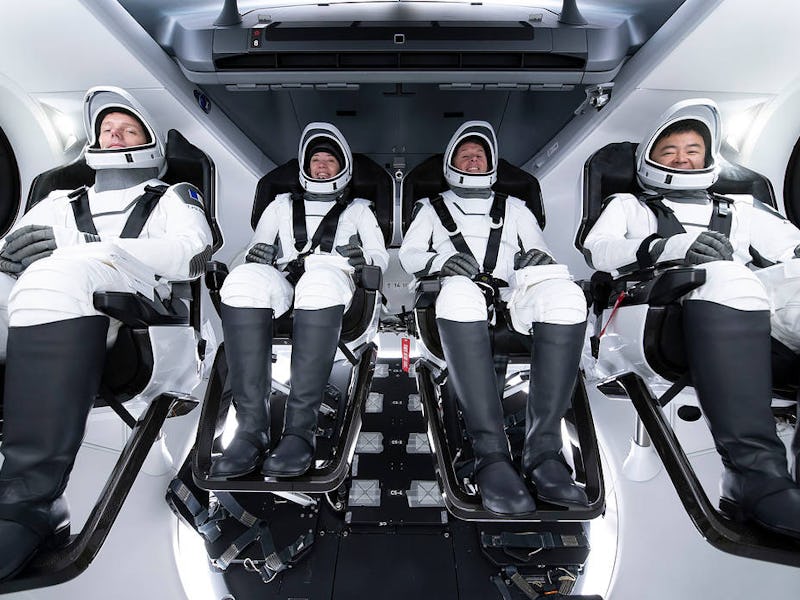SpaceX Crew-2 launch date, astronauts, and return for the NASA ISS mission
Here’s everything you need to know.

Before Elon Musk can take his place as the “Imperator of Mars,” SpaceX has to prove it can reliably ferry astronauts to the International Space Station.
SpaceX’s Crew Dragon rocket program is about to make its third trip to the ISS, a job that NASA hired Musk’s firm to complete instead of building its own rockets. This third trip will reuse the Endeavor module that first proved SpaceX could reach the station at all. Here’s everything you need to know about NASA’s SpaceX Crew-2.
SpaceX Crew-2 launch date, time, and location
The SpaceX Crew-2 mission is scheduled to launch no earlier than 6:11 a.m. Eastern on Thursday, April 22. The flight to the International Space Station is estimated to take 23 hours and 39 minutes, so the onboard astronauts will not meet their new ISS colleagues until Friday at 5:30 am Eastern. The astronauts have already begun to quarantine, as a precaution during the Covid-19 pandemic
The mission will launch from NASA’s Kennedy Space Center in Florida, and then dock at the forward, Earth-facing port on the ISS. To make room, the astronauts currently onboard the ISS cleared a parking spot for the new crew last week.
The Crew-1 team, which previously flew to the ISS using SpaceX’s Crew Dragon, moved their craft, Resilience, to a different holding port on the station on Monday, April 6. This was the first time a Crew Dragon capsule autonomously relocated to a different port on the ISS. The Crew-1 team will return to Earth on April 28.
SpaceX Crew-2 astronauts
The Endeavor will carry two NASA astronauts, Shane Kimbrough and Megan McArthur, as well as the Japan Aerospace Exploration Agency’s Akihiko Hoshide and the European Space Agency’s Thomas Pesquet. This is the first time a commercial space crew (meaning a SpaceX or other commercial rocket, rather than a NASA launch) has flown with international partner astronauts.
The Crew-2 is SpaceX’s first international manned mission.
Commander Shane Kimbrough
Kimbrough, the commander of the spacecraft and mission, has spent a total of 189 days in space and performed six spacewalks, according to NASA. He first launched into space in 2008, on the STS-126 Endeavour mission, which expanded the livability of the ISS by adding a new bathroom, kitchen, bedrooms, water recycler, and exercise machine.
His second mission to the ISS launched in October 2016, and he spent 173 days on the station before returning to Earth in April 2017.
Pilot Megan McArthur
While McArthur hasn’t yet been to the ISS, she has been to space before. Her first and only mission so far was the final servicing of the Hubble Space Telescope in 2009, where she worked as the mission’s flight engineer. McArthur operated the robotic arm aboard the shuttle to grab the telescope, and used the arm to assist her crewmates during spacewalks. The mission lasted nearly 13 days.
Mission Specialist Akihiko Hoshide
Hoshide has been to the ISS twice before. He flew to the station once in 2008 to deliver Japan’s “Kibo” experiment module, which allows astronauts to perform experiments in a pressurized chamber, as well as exposed to space.
Hoshide returned to the ISS in 2012, when he stayed aboard for 124 days to perform experiments using the Kibo module, deployed satellites, and helped uncrewed missions that delivered supplies to the station.
Mission Specialist Thomas Pesquet
Pesquet is returning to the station for a second time. He has the most time logged on the ISS of the Crew-2 team, previously spending 197 days aboard the station from 2016 to 2017.
During that first trip, he operated the station’s robotic arm to capture two cargo spacecraft and assist docking them to the station.
Pesquet’s talents don’t stop at spaceflight and robot arm operation: One of his duties on board will be to perform magic tricks in low-gravity. The magic-trick experiment will be recorded for a video to inspire kids to pursue STEM careers, and will explain how an astronaut’s central nervous system adapts to space.
SpaceX Crew-2 mission and experiments
The SpaceX Crew Dragon capsule in 2020 after landing in the Gulf of Mexico.
Parlor tricks won’t make up a majority of the mission, though. The Crew-2 team are tasked with a wide range of experiments over their six-month stay, from building artificial retinas to studying “cool flames.” (Cool refers to the temperature, not how rad a space fire might be.)
In the case of the artificial retinas, NASA explains that the microgravity environment of the space station might be a more stable location to build the delicate layers of proteins that would replicate the sensitive human tissue. The experiment will be conducted autonomously by a CubeLab, with minimal involvement needed from the astronauts.
“Cool flames” were only discovered in 2012 aboard the ISS, and has proven to be a phenomenon difficult to replicate on Earth. While a typical candle might burn at 1400 degrees Celsius, a cool flame only burns at 600 degrees. Scientists also noted that cool flames burned without soot or visible byproducts, making scientists interested in the chemistry’s application to combustion engines in cars.
SpaceX Crew-2 return date
After the launch, the Falcon 9 rocket used to launch the Crew Dragon capsule will return itself to Earth. This is the same rocket that brought Crew-1 to the ISS, making it the first time a rocket has been re-used for a crewed launch, according to NASA.
About five days after the Crew-2 astronauts arrive at the ISS, the Crew-1 team will return back to Florida aboard the Resilience. They will have a full six-month cycle aboard the ISS.
The Crew-2 astronauts are also scheduled to spend 6 months aboard the ISS, and likely will come back to Earth aboard the Endeavor shortly after Crew-3 arrives on the station in October 2021.